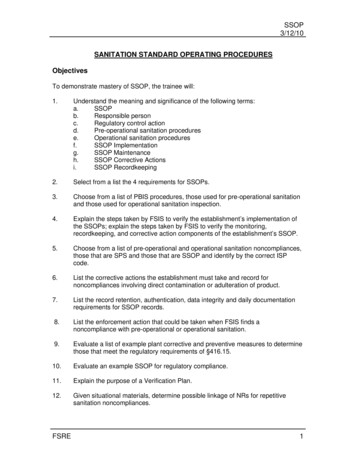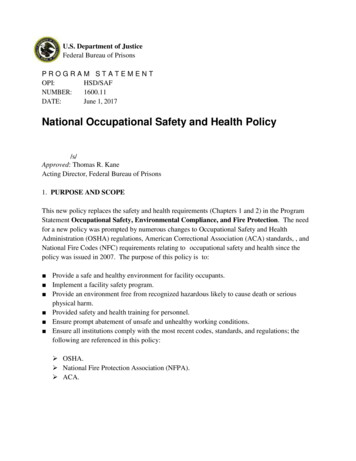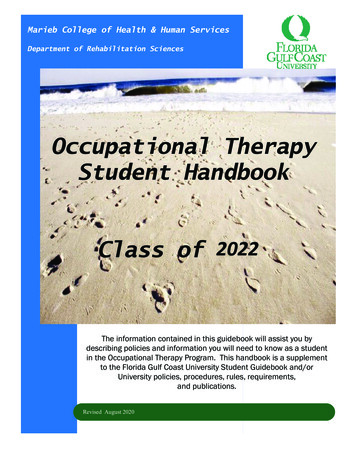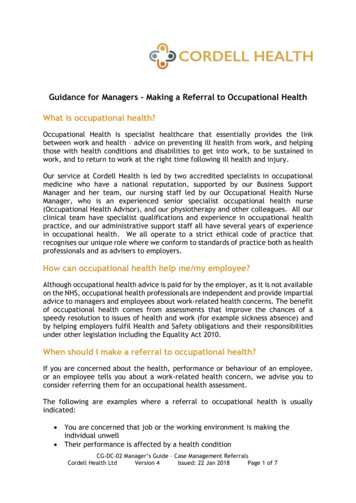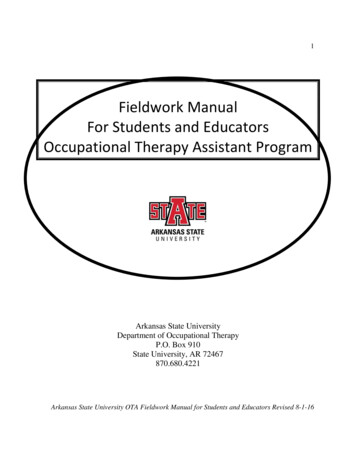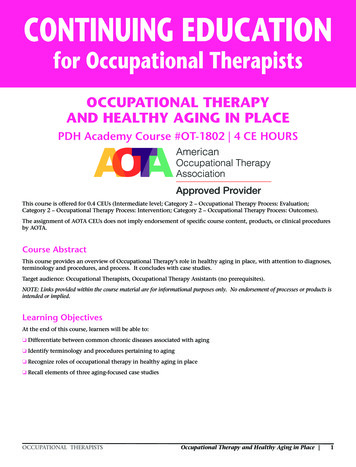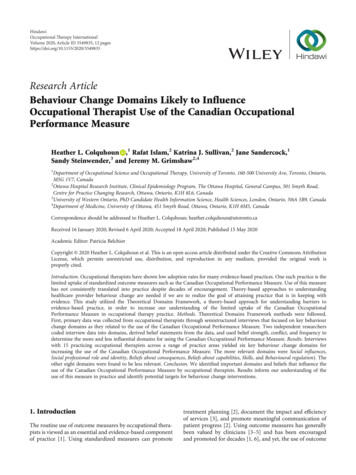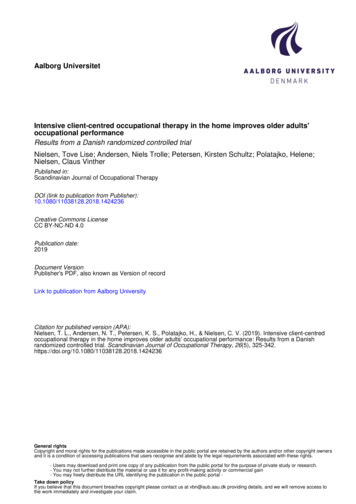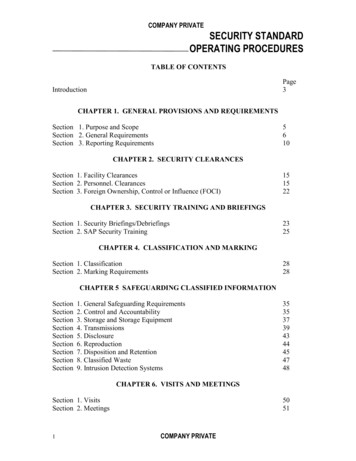
Transcription
Version #:1{Organization}{Logo}{Document #:}Page 1 of 139Title:STANDARD OPERATING PROCEDURES FORSAFETY AND HEALTH TRAININGEffective Date:MM/DD/YYYYAPPENDIX B1.Introduction1.1BackgroundThis information has been developed to assist federal agencies in the developmentof safety and health training and is intended to assist Federal Agencies as they strive toimprove workplace health and safety. While we attempt to thoroughly address specifictopics or hazards, it is not possible to include discussion of everything necessary toensure a healthy and safe working environment in a document of this nature. Thus, thisinformation must be understood as a tool for addressing workplace hazards, rather thanan exhaustive statement of an employer’s legal obligations, which are defined by statute,regulations, and standards. Likewise, to the extent that this information referencespractices or procedures that may enhance health or safety, but which are not required by astatute, regulation, or standard, it cannot, and does not, create additional legal obligations.Finally, over time, OSHA may modify rules and interpretations in light of newtechnology, information, or circumstances; to keep apprised of such developments, or toreview information on a wide range of occupational safety and health topics, you canvisit OSHA’s website at www.osha.gov.This Standard Operating Procedure (SOP) is intended as a template that Federal Agenciescan use to improve their safety and health training. It may be useful for Federal Agenciesto develop other policy and procedures as a companion to this SOP. Furthermore, theappendices contain references and documents that do not apply universally to all FederalAgencies. The intent of this document is to provide research that can be tailored to thespecific agency so that the training developed can promote safe and healthy workplaces.1.2PurposeThis document establishes procedures that govern safety and occupational health (OSH)training, including training management, development, delivery, evaluation, and recordkeeping for personnel working at {organization}. This training standard operatingprocedure (SOP) is intended to document the {organization’s} commitment to providenot only training that is required by regulation (federal, state, local) or policy but also toaffirm the {organization’s} commitment to continued OSH excellence. At stake areinjuries and illnesses that occur to our personnel because personnel are not properlytrained to do the jobs assigned to them.This SOP fulfills the requirements of {name of Safety and Health Management System(SHMS), e.g. OHSAS 18001:2007 or ANSI/AIHA Z-10:2012} for identification ofcompetency requirements associated with those personnel who work in jobs that involveimplementing, maintaining and/or improving Safety and Health Management SystemUncontrolled when printed: 7/28/2014For the most current copy, check the { list on the (location of electronic file)}For Internal Use Only
Version #:1{Organization}{Logo}{Document #:}Page 2 of 139Title:STANDARD OPERATING PROCEDURES FORSAFETY AND HEALTH TRAININGEffective Date:MM/DD/YYYYAPPENDIX B(SHMS) components; and/or apply OSH operational controls. This SOP was also adaptedfrom ANSI/ASSE Z490.1 (2009) as it relates to consensus criteria for accepted practicesin safety and health training. This SOP also aligns with {other orders or guidelines relatedto activities associated with training requirements}.1.3ObjectivesThe following objectives will be addressed in this SOP: 1.4Presentation of unambiguous and relevant safety and health trainingrequirements appropriate for each position and individual;Criteria used to establish relevance of proposed training to requiredcompetencies;Compliance with federal, state and local regulatory safety and health trainingrequirements as well as agency/regional policy;Clear roles and responsibilities for management and staff charged withproviding safety and health training;Factors that shall be considered when choosing training coursework/providersto help assure training is of high quality;Documentation and tracking that is readily accessible and allows the safetyand health professionals, employees and their managers to access the status ofan individual’s training in real time.Documentation and tracking that allows management to assess theeffectiveness of the training program.ScopeThis procedure applies to any kind of training completed by personnel employed at{organization} where work performance includes training required by regulation orstatute, or training helps ensure the fulfillment of OSH and/or SHMS-related duties,responsibilities and competence of personnel.2.Activities AffectedAll operations within {Organization’s} SHMS scope.3.Related Documents and Forms3.1{Organization’s} SHMS Manual, Section {#.#}Uncontrolled when printed: 7/28/2014For the most current copy, check the { list on the (location of electronic file)}For Internal Use Only
Version #:1{Organization}{Logo}{Document #:}Page 3 of 139Title:STANDARD OPERATING PROCEDURES FORSAFETY AND HEALTH TRAININGEffective Date:MM/DD/YYYYAPPENDIX B3.23.33.43.53.63.73.83.93.103.114.Relevant clauses of SHMS standard (e.g. OHSAS 18001:2007 clause 4.4.2,Competence, Training and Awareness, ANSI/AIHA Z-10:2012 clause 5.2Education, Training, Awareness and Competence)Safety and Health Management PlansWork Control Plan Review Form{Organization’s} Safety and Health Program Guideline (Date){Organization’s} Safety and Health Guideline for Job Hazards Analyses (Date)Code of Federal Regulations, Title 29, Parts 1910, 1926, and 1960{Organization’s} Order ####.#, Safety and Health Management ProgramOSHA Publication 2254, Training Requirements in OSHA Standards andTraining GuidelinesANSI/ASSE Z490.1 (2009) Criteria for Accepted Practices in Safety, Health, andEnvironmental TrainingDesigning and Delivering Effective Training, Susan M. McMaster, CIT, NationalEnvironmental, Safety and Health Training Association, 2004.Definitions4.1Competency: Capability to minimize the risk to safety and health though systemeffectiveness and individual performance.4.2Control: Physical or administrative action, or a combination of these, applied to agiven operation or activity that reduces the actual or potential risks associatedwith identified hazards of that activity or operation. A control is applied toeliminate and/or reduce risks to acceptable levels, if possible and practical.Training is considered an administrative control.4.3Formative assessment: Assessment techniques used by training providersduring learning activities to improve learning content and trainee performance.4.4Hazard: Source, situation or act with a potential for OSH consequence in termsof human injury or ill health/illness, or a combination of these. It also applies tothe potential for damages to or destruction of {organization} property or otherassets.4.5Health training: Any activity provided to personnel to gain, improve, or retainknowledge, skills, or abilities related to the adaption of work to the worker and/orthe worker to the job, e.g. ergonomics training and wellness training; or, trainingrelated to health hazards.Uncontrolled when printed: 7/28/2014For the most current copy, check the { list on the (location of electronic file)}For Internal Use Only
Version #:1{Logo}{Organization}{Document #:}Page 4 of 139Title:STANDARD OPERATING PROCEDURES FORSAFETY AND HEALTH TRAININGEffective Date:MM/DD/YYYYAPPENDIX B4.6Ill health or illness: Identifiable, adverse physical or mental condition arisingfrom and/or made worse by a work action, activity and/or work-related situation.4.7Learning objective: A statement in specific and measurable terms that describeswhat the learner will know or be able to do as a result of engaging in the learningactivity.4.8Personnel: All managers, employees, contractors and subcontractors, grantees,interns, volunteers or others who may be involved with any of the work actionsperformed in or on the facilities or involved with the organizations managed fieldwork.4.9Risk: Combination of the probability of an occurrence of an OSH consequenceand the severity of that consequence that can be caused by a hazard.4.10OSH Management Plans (SHMPs): Written plans which guide achievement ofestablished objectives and targets, and are directly linked to them. SHMPs containdetails on the resources (e.g., financial, human, and technological) and timeframesto accomplish the objectives and targets. They also contain information describingthe approaches and strategies for achieving objectives and targets, as well asperformance indicators, applicable operational controls, roles and responsibilitiesto accomplish tasks, and competency requirements for individuals to accomplishthose tasks. The SHMP ties many elements of the SHMS together (e.g., priorityhazards and risks, objectives and targets, resources, responsibilities, andcapabilities) and provides an integrated view of the disparate requirements in theSHMS.4.11Safety training: Any activity provided to personnel to gain, improve, or retainknowledge, skills, or abilities related to helping them to become more safetyconscious in aspects of safety.4.12OSH consequence: Any adverse change to an employee’s, grantee’s, student’s,contractor’s or visitor’s health or well-being resulting from the organization’sfacilities, operations, activities, products and/or services.4.13Summative assessment: The trainee is administered a test which is designed tosummarize what has been learned.4.14Work control plan (WCP): A document that includes detailed informationabout particular work actions (recurring or non-recurring), and providesUncontrolled when printed: 7/28/2014For the most current copy, check the { list on the (location of electronic file)}For Internal Use Only
Version #:1{Logo}{Organization}{Document #:}Page 5 of 139Title:STANDARD OPERATING PROCEDURES FORSAFETY AND HEALTH TRAININGEffective Date:MM/DD/YYYYAPPENDIX Bidentification of the hazards and risks associated with those work actions.Additionally, the document will include or reference controls that define thenecessary actions that will be taken during conduct of the work actions toeliminate, avoid and/or minimize the identified hazards and risks. The WCPrequires preparation, review, approval, maintenance and/or closure according tothis procedure.4.155.Workplace: Any physical location in which work-related activities of theorganization are performed under the control of the organization. This includesthose activities involved with field work, personnel in transit (plane, train,automobile) or other non-traditional locations or situations in which the{organization} employees, or those working on the {organization’s} behalf,complete work actions.Roles and Responsibilities5.1Managers and Supervisors5.1.1 Are ultimately responsible for assuring that an appropriate level ofeffective health and safety training is occurring within or originating fromtheir organizations.5.1.2 Supervisors shall assure that an employee does not perform work prior toreceiving appropriate work-related training.5.1.3 Supervisors shall assure that changes in methods or introduction of newanalyses are evaluated for changes in training requirements and that anychanges are included in the Work Control Plan and communicated to theHealth and Safety Manager.5.1.4 Management shall review the results of safety audits for site compliance.5.2Safety and Health Managers shall:5.2.1 Ensure that sources of training are of high quality and appropriatelyaddress training needs;5.2.2 Monitor training records to make certain that the type of training andtraining frequency required by statute/regulation is occurring;5.2.3 Conduct/oversee training as appropriate;5.2.4 Update training requirements per job hazard analyses and work controlplans or as mandated by regulation or statute;5.2.5 Maintain documentation of training records.5.3Site Employees:5.3.1 Shall comply with training requirements by attending training germane totheir job assignment.Uncontrolled when printed: 7/28/2014For the most current copy, check the { list on the (location of electronic file)}For Internal Use Only
Version #:1{Organization}{Logo}{Document #:}Page 6 of 139Title:STANDARD OPERATING PROCEDURES FORSAFETY AND HEALTH TRAININGEffective Date:MM/DD/YYYYAPPENDIX B5.3.25.3.36.Should be pro-active in identifying areas for which they believe trainingshould be enhanced/upgraded to allow them to understand and manage therisks associated with their job assignment.Shall check their on-line training records for accuracy.Planning for TrainingFundamental in planning for training is the identification of competency requirements andmethods (including training) which may be used to obtain competency. As training iscoordinated and implemented, competency can be reassessed from lessons learned throughoutthe process and a focused evaluation of the effectiveness of completed training. The followingfigure portrays this management system approach for ensuring competency and effectivetraining, and identifies corresponding sections/paragraphs in this SOP.Uncontrolled when printed: 7/28/2014For the most current copy, check the { list on the (location of electronic file)}For Internal Use Only
Version #:1{Organization}{Logo}{Document #:}Page 7 of 139Title:STANDARD OPERATING PROCEDURES FORSAFETY AND HEALTH TRAININGEffective Date:MM/DD/YYYYAPPENDIX BIdentify positions with OSH/SHMS duties6.1.1Determine baseline levels ofeducation, experience & training6.1.2Define core competencyrequirements for each position6.1.3PlanDetermine training and othercompetency assurance methods6.1.4Identify training and other actionsneeded by the individual6.1.5Identify training goals andobjectives6.1.6DoCoordinate, implement, andmonitor competence trainingactionsCheckEvaluate effectiveness ofcompetence/training actions8ActLessons learned8.2Figure 01: Ensuring CompetencyUncontrolled when printed: 7/28/2014For the most current copy, check the { list on the (location of electronic file)}For Internal Use OnlyMonitorFeedback
Version #:1{Organization}{Logo}{Document #:}Page 8 of 139Title:STANDARD OPERATING PROCEDURES FORSAFETY AND HEALTH TRAININGEffective Date:MM/DD/YYYYAPPENDIX B6.1The following process shall be used to determine what training or other actionsare needed:6.1.1Identify all positions (not individuals) in the organization withOSH/SHMS duties and responsibilities. There are many sources foridentifying these positions, e.g., position descriptions, knowledge amongsupervisors or other management personnel, OSH/SHMS procedures, andSHMPs among others.6.1.2 Determine relevant and necessary baseline levels of education, experienceand training that help define competence for each of these identifiedpositions, i.e. baseline competency requirements for a given position. Thisstep should include an analysis of an appropriate progression in levels ofeducation, experience and training according to grade/pay bands and forsupervisory/non-supervisory positions. Sources of information includethose listed in paragraph 6.1.1; review of job vacancy announcements;documented roles, responsibilities, authorities and accountabilities;discussions with supervisors, managers and others with extensiveexperience; official career maps and ladders; OSHA regulations; OPMqualification standards, Department of Defense resources, AmericanNational Standards Institute (ANSI) and American Society of SafetyEngineers (ASSE) standards and resources, National Fire ProtectionAssociation guidance, National Electrical Code guidance, and the Boardof Certified Safety Professionals resources.6.1.3 Define the core competence requirements for each identified position.An example of the competency requirements developed for a specificposition is provided at Appendix A, OSH Core Competencies for FacilityManager. This form or a similar form should be used to identify corecompetencies for each identified position.6.1.4 Identify training or other types of competence-assurance materials oraction options that are available – create new materials or relevant actions,if necessary. Some training may be specified by regulation, other types oftraining may be considered necessary according to the local OSHprogram/SHMS. Appendix B lists categories of federal employees andtheir OSH training requirements according to 29 CFR 1960. Appendix Cprovides a list of training courses for a national organization. Mentoring,cross-training, temporary assignments, formal education or careerdevelopment programs are other available action options. Professionalassociations and their certification programs may be appropriate means ofassuring competency for certain positions such as in the Safety andOccupational Health Management series, GS- 0018: Board of Certified Safety Professionals (BCSP) – www.bcsp.orgUncontrolled when printed: 7/28/2014For the most current copy, check the { list on the (location of electronic file)}For Internal Use Only
Version #:1{Organization}{Logo}{Document #:}Page 9 of 139Title:STANDARD OPERATING PROCEDURES FORSAFETY AND HEALTH TRAININGEffective Date:MM/DD/YYYYAPPENDIX Bo CSP – Certified Safety Professional American Board of Industrial Hygiene (ABIH) – www.abih.orgo CIH - Certified Industrial Hygienist American Board of Health Physics (ABHP)o CHP - Certified Health PhysicistLists should be developed of training and competency requirements forspecific positions and for groups of employees. Examples of these lists areprovided at Appendix D. Ultimately, a master training plan that identifiescompetencies, knowledge, skills, and abilities, recommended education,training, assignments, and self development opportunities should bedeveloped for each position.6.1.5Determine training or other appropriate actions that are needed by theindividual to fulfill the duties and responsibilities and ensure personnelcompetence. A skills assessment based on criteria in master training or career plansshould be conducted for new job assignments. New employees typically must complete training requirements beforeperforming related work tasks, and an initial safety and health trainingcourse covering baseline 29 CFR 1960 elements (as listed in AppendixE) should be provided within the first 2 weeks of employment. Associated actions such as medical surveillance and respirator fittesting should also be identified based on regulatory requirements,WCPs, job hazard analyses, work site characteristics, etc. Theseassociated actions should be listed on work-specific forms such as theWCP provided at Appendix F. Previous training or experience should be considered. For example, thetype and amount of HAZWOPER training is dependent upon whattraining and experience has already occurred. Some types of refreshertraining may not be required if an appropriate understanding of thelearning objectives can be demonstrated. Perspectives of employees, their supervisors/managers, andsubordinates are helpful in determining what training or other actionsare appropriate. For example, discussions with those involved withpermit-required confined space entry can provide information as towhether there continues to be an effective understanding of each teammember’s roles and responsibilities, whether specific procedures arereasonable for the team, whether proper equipment is available, andwhether previous training has been valuable. Observation of unsafebehavior may initiate on-the-job training for vehicle operator. Trainingmay be required to ensure OSH requirements are communicated asUncontrolled when printed: 7/28/2014For the most current copy, check the { list on the (location of electronic file)}For Internal Use Only
Version #:1{Logo}{Organization}{Document #:}Page 10 of 139Title:STANDARD OPERATING PROCEDURES FORSAFETY AND HEALTH TRAININGEffective Date:MM/DD/YYYYAPPENDIX Bintended for some unique cultures or languages. Some employees mayhave special abilities or disabilities, or motivational issues which mayaffect the amount and type of training required. Where feasibletraining should take into consideration these factors. Systems for career/developmental tracking (including supervisor andmentor recommendations and corresponding employee actions) arerecommended to assure appropriate progression in safety and healthassignments and responsibilities.6.1.6 Identify relevant training goals and objectives. This may requiremodifications to Individual Development Plans, prioritizing trainingaccording to regulatory and professional requirements, and the availabilityof personnel and suitable providers. Sources of information arecommunications from supervisors/employees, previous training reports,skill assessment forms, existing systems for career tracking, policy andprocedures for competency development, and competency-based humancapital strategic plans. Summary reports such as one at Appendix G shouldbe developed to assist supervisors and employees in completingrequirements during the calendar year.6.2Training shall be conducted by qualified provider(s) that meet at least one of thefollowing conditions: Nationally recognized source of training such as the National Safety Council; An industry recognized training source; Third-party accredited training source which is accredited by an organizationthat offers certification or approval, for example, a training provider for firstaid training which is certified by the American Red Cross, the American HeartAssociation, American Safety and Health Institute; or a federal or stateapproved training provider for an asbestos training program, as defined in therevised Model Accreditation Plan (40 CFR, Part 763); Training product provided by a federal, state or local governmental agencysuch as EPA’s power points developed to train employees about chemicalwarfare agents; Training product provided by an accredited college or university; Trainer who is considered qualified by the safety and health manager as aresult of education, training or experience that demonstrates current subjectmatter expertise and competency in delivery skills appropriate to adultlearning (training materials can be in-house or commercial products).6.3Trainers shall develop written lesson plans or course guides which meet theminimum requirements identified on the lesson plan form (including comments)at Appendix H.Uncontrolled when printed: 7/28/2014For the most current copy, check the { list on the (location of electronic file)}For Internal Use Only
Version #:1{Organization}{Logo}{Document #:}Page 11 of 139Title:STANDARD OPERATING PROCEDURES FORSAFETY AND HEALTH TRAININGEffective Date:MM/DD/YYYYAPPENDIX B 6.46.56.67.Conducting Training7.17.27.38.Learning objectives shall consider the training background and experience ofthe trainee and be SMART (Specific, Measureable, Achievable, Reasonable,and Timely)Appropriate individuals in the organization (e.g. the safety and health manager ortraining coordinator) shall identify the evaluation method(s) to be used, e.g.perspectives from the trainee, trainer, workplace, and/or organization prior totraining delivery using a form such as the one provided at Appendix I.The {organization} shall provide sufficient resources for training for each fiscalyear.When relevant, training hours completed in the last quarter of the year may beforwarded to the next year’s training requirements if total required hours oftraining for the current year have been completed.Training shall be conducted in a timely manner based on regulatory and agencyrequirements, and organizational priorities.Competency must be assured. Each new hire must complete those trainingrequirements identified by their position description before performing a taskassociated with a training requirement.Training delivery requirements are identified on the delivery record form atAppendix J. Trainers and/or training coordinators may use this form or a similarform at least meeting these requirements.Evaluating Training8.1Training management/administration, methods, and results shall be evaluated.8.1.1 Management /Administration {Frequency (e.g. quarterly or annual)} internal audits shall be used toevaluate this SOP for the adequacy of the written accountabilitysystem and the training processes. The following parameters will bepart of this assessment:o Training type and frequency are on track for required training to becomplete in the FY for which it is scheduled (80% on time /- 2month window).o 10% of tracked employees are at least 95% accurately recorded asverified by employee concurrence with training manager records.o All site employees have met at least the FY 8.0 hour site health andsafety training requirement as verified through trainingdatabase/spreadsheet.Uncontrolled when printed: 7/28/2014For the most current copy, check the { list on the (location of electronic file)}For Internal Use Only
Version #:1{Organization}{Logo}{Document #:}Page 12 of 139Title:STANDARD OPERATING PROCEDURES FORSAFETY AND HEALTH TRAININGEffective Date:MM/DD/YYYYAPPENDIX B {Frequency (e.g. quarterly or annual)} internal audits shall alsoinclude an evaluation of the adequacy of the training resources,facilities, equipment, and records through discussions withmanagement and training providers, and review of training evaluationrecords.8.1.2 MethodsLearning objectives, content, and effectiveness shall be evaluated aftereach training event, by the safety and health manager/training coordinatorand the training provider.8.1.3 ResultsCompetence, needs assessment, professional/career development, annual,long-term (vision focus), and strategic (strategy focus) training plans,overall effectiveness. Survey (SF-003 Employee Safety Training Survey) of all siteemployees between June and October to assess if they believed thattraining was adequate for their needs and to solicit suggestions fortraining needs in the coming FY. Review of WCP’s/JHA’s generated in the FY shows 100% update oftraining requirements by job description identified in these documents. Recommendations of the Health and Safety Committee; Management requests/responses to the {organization’s} changingmission. A key measure of the effectiveness of the Training Program will be thenumber of work-related accidents, illnesses and near misses. The{organization} goal is zero work-related accidents and illnesses. {Frequency (e.g. quarterly or annual)} internal audits shall be used toevaluate the overall effectiveness of the training curriculum/programand reasonableness of future plans. Annual SHMS management reviews will include audit findings of thetraining program, including the adequacy of the training resources,facility, equipment, and future plans taking into considerationchanging missions and competing priorities.8.2Continuous Improvement/Updates to Program RequirementsThe following resources will be used to assure continuous improvements andupdates to the Health and Safety Training Program. {Organization} issued updates for federal rules and regulations; {Other, e.g. State} issued updates for rules and regulations; Employee Safety Training Surveys; Information from training evaluations; Recommendations of the Health and Safety Committee;Uncontrolled when printed: 7/28/2014For the most current copy, check the { list on the (location of electronic file)}For Internal Use Only
Version #:1{Logo}{Organization}{Document #:}Page 13 of 139Title:STANDARD OPERATING PROCEDURES FORSAFETY AND HEALTH TRAININGEffective Date:MM/DD/YYYYAPPENDIX B 9.Management requests/responses to the {organization’s} changing mission.Documentation and Record Keeping9.1Ensure training and competency requirements are documented and records arekept. As the competence requirements and training needs are determined theymust also be recorded in position descriptions, procedures, plans, manuals,etc. Records must be maintained that demonstrate each individual assigned to aspecific position that includes OSH/SHMS responsibilities fulfills thenecessary competence requirements on initial assignment to the position. Training records shall use the standardized course titles at Appendix C. The{organization} training manager shall be contacted to add new course titlesto the list. All competence and training records shall be maintained and protected inaccordance with {organization’s} records management procedure formeeting regulatory requirements for availability, disclosure, confidentiality,and protection of trade secrets.9.2Training certificates shall meet the minimal information requirements shown onthe sample training certificate at Appendix L.9.3Personnel responsible for the development of training records must have a clearunderstanding of the requirements for the record and record retention skills. Theymust also possess technical expertise and direct experience related to the record,or ensures the record is reviewed by those that have relevant expertise orexperience. These qualifications must be verified by management representativesthat oversee record development before record development begins and duringprogram assessments.9.4The records generated by this SOP include the following.9.4.1 Job-Specific OSH Core Competencies (Example: Appendix A)9.4.2 List of training courses (Example: Appendix C)9.4.3 Training/Competency Lists for specific positions/groups of employees(Examples: Appendix D)9.4.4 Training portion of Work Control Plans (Example: Appendix F)9.4.5 Annual Training Summary Report (Example: Appendix G)9.4.6 Lesson Plan (Appendix H)9.4.7 Training Delivery Record (Appendix I)9.4.8 Training Evaluation Record (Appendix J)9.4.9 Training Certificate (Appendix K)Uncontrolled when printed: 7/28/2014For the most current copy, check the { list on the (location of electronic file)}For Internal Use Only
Version #:1{Organization}{Logo}{Document #:}Page 14 of 139Title:STANDARD OPERATING PROCEDURES FORSAFETY AND HEALTH TRAININGEffective Date:MM/DD/YYYYAPP
This document establishes procedures that govern safety and occupational health (OSH) training, including training management, development, delivery, evaluation, and record keeping for personnel working at {organization}. This training standard operating procedure (SOP) is intended to document the {organization's} commitment to provide

